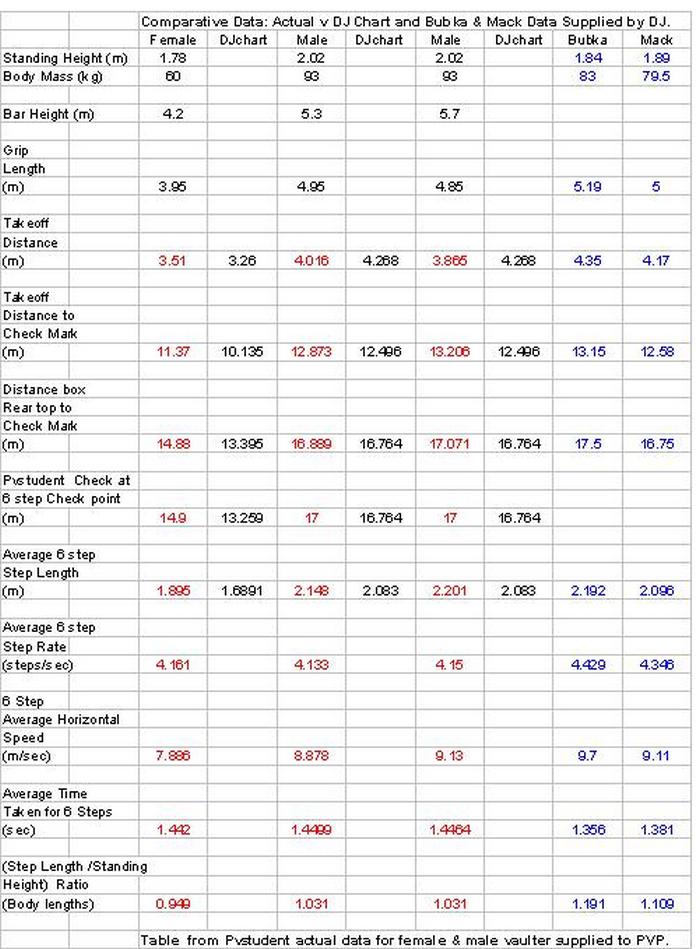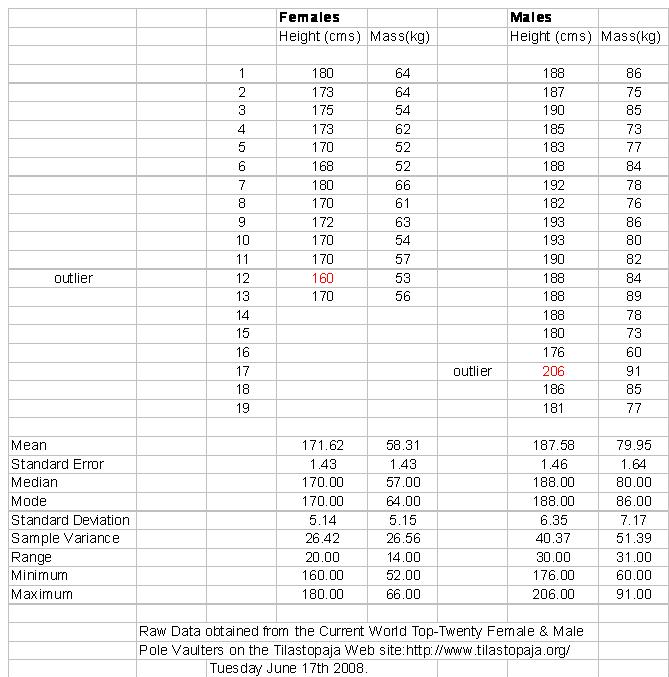ladyvolspvcoach wrote:Actually, neither of these can be true. I coach that an overstride is the extension of the heel beyong the knee and if you look neither of these ladies is guilty of that behavior.
Ahh, we have a conflict in terms. By overstride, I meant simply that the athlete's footstrike was horizontally ahead of the an imaginary line drawn straight down from the athlete's centre of mass (DJ posted this somewhere). It is very possible for this to happen without an athlete's toe extending beyond their knee. It could be what's happening in that video.
I'm curious, what makes you choose this definition of overstriding? To me it seems descriptive, rather than prescriptive. I'll bet for many athletes it's a very effective indicator--it seems to have worked well for your ladies. But think about this example...There's a vaulter here people call stilts. Her legs are EXTREMELY long overall, but the length is disproportionately distributed between her upper and lower legs. Her femurs are of average length for a girl, even for a girl much shorter than she is. But her forelegs are RIDICULOUSLY long. Like, comically long. Now, when she runs, by your definition of overstriding, she overstrides BADLY--her toes go way past her knees. But her foot placement is just fine; it's right underneath her centre of mass. If you told her not to let her toes go past her knees, she'd be turning over quickly, but without force--"spinning her wheels," so to speak.
But getting back to the Dartfish clip of your two Lady Vols, I still think it's possible the short one is overstriding (by the above definition), or the tall one is understriding, or both. But it's also possible that they're not, and they're both running as effectively as they can given their current abilities. If this is the case, then by necessity, the shorter vaulter must be a stronger runner than the taller vaulter in the sense that each foot impact is more forceful and shorter in time (i.e. for each stride her foot is in contact with the ground for less time than the taller vaulter's strides).
I think it would be interesting to compare the footstrikes of these vaulters, or two like them in a similar situation. I'll bet the shorter one's feet are on and off the ground quicker. Now if that hunch is correct, then consider this...
What happens when the taller vaulter becomes a stronger running (over time through both physical and technical training). Her footstrike time would come decrease, force would increase, and her strides would be longer, meaning her start mark AND mid mark would need to move back. You could deal with this one of two ways:
1. If she can handle it, move her grip up. This would keep her in line with DJ's chart.
2. Move her too a stiffer pole. This would put her mid outside of that prescribed in the chart.
This is one reason why I think any given vaulter's "ideal" or "proper" 6-step check mark can fall outside of the prescribed mid if an athlete's on a stiff pole, or inside of it if they're on a soft pole. Remember, poles bend and penetration occurs according to energy, and energy comes not just from the ground (impulse at takeoff) but also the work on the pole. Now since the ground work (impulse at takeoff) is the greatest contributor of energy by far, it makes sense that grip height is highly related to impulse at takeoff, which is why DJ's chart works even if it doesn't completely make sense. But what if you notice that your (now stronger) taller vaulter is being a little lazy on the top end and you choose option #2 above to work on it? Well then her mid is now off the chart (outside).
BUT if you move her up in grip on a pole of the same relative stiffness, she'll still be "on the chart," so to speak. The conclusion: the chart relates two variables: energy from run and grip height, plus or minus a certain amount depending on the size of the vaulter. The CONTROLLED variable in the chart is the energy from the second phase, which can correlate with pole stiffness.
Maybe the question is, what is the amount of the controlled variable (pole stiffness)? How to we quantify this and manipulate it to fit the chart? Perhaps DJ should add a note to the bottom that says "Chart applies when vaulting on a pole of the nearest possible length such that the vaulter can hold right below the tape with stiffness rated 10-20lbs/5-10kg above the body weight of the vaulter." (note: 10-20lbs is a baseless, made up number, but seems right-ish on instinct)
For vaulters with lower grips on stiffer poles, wouldn't their 6-step check be further out than that prescribed by the chart? And wouldn't their height clearances be higher than what corresponds to their grip on the chart?
also my intent was to provide visual and tangable results that could be discussed not judged. This was not intended to prove any point but to present a sense of reality to the application of the data in the chart.
And that you have--look what it got us talking about! I didn't mean to imply otherwise.
ladyvolspvcoach wrote:This is a possible point of contention, but I coach that you accelerate to the mid then attempt to get your feet down as fast as you can from the mid to the take off with a specific focus on the penultimate and take off. You cannot execute these last two steps effectively if you are attempting to accelerate into the take off. So no, the length of the run does not change the mid mark.
Hmm...you may be right that it's better to sacrifice acceleration for a good takeoff coming into the last step. I don't know about the penultimate step though. At any rate, you can certainly accelerate right up until the penultimate step though It doesn't make sense to hit your mid mark and just "coast."
But about the mid make/approach length relationship. Consider a more extreme example. One vaulter, two jumps, same grip. One jump with 5 left approach, one with 9 left. When the vaulter is 3 lefts out (at their mid), they have a LOT more speed at that point on their 9L approach than they do on their 5L approach because they have a whole 8 more steps worth of acceleration. The distance form mid to takeoff will be covered much faster. Their steps will be longer. If their run from 5L was on, they would either have to slow way down or they'd take off way inside (or a bit of both).
Now I know it's a bit preposterous to grip the same height off of 5L and 9L, but it's entirely possible if a stiffer pole is used for 9L. So that's how pole stiffness and approach length are related if grip height is kept constant, how they can push the ideal 6-step mid in or out.

